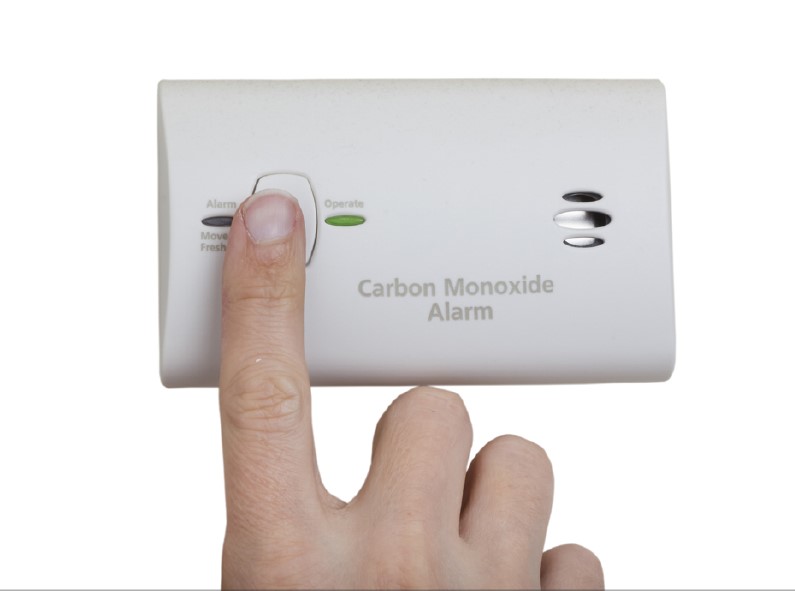Whether it’s the first one, an upgrade or a timely replacement, this safety device is a must-have for your home.
A carbon monoxide detector is not likely to be at the top of anyone’s holiday wish list. But maybe it should be.
If your Georgia home uses any fuel-burning appliances or has an attached garage or fireplace, you need a carbon monoxide detector. Carbon monoxide, or CO, is created when fuels such as gasoline, wood, natural gas, coal and propane don’t burn completely. It can be a major hazard in the winter when people burn fuels to stay warm.
Carbon monoxide is nearly impossible to detect without a detector.
Carbon monoxide is nearly impossible to detect without a detector. It is a colorless and odorless gas, which can be deadly upon exposure. With a CO detector in your home, your family will receive an alert when unsafe levels of carbon monoxide are within the home.
Since January 2009, Georgia state law has mandated that every newly constructed one and two-family dwelling and townhome be required to have at least one CO alarm. Still, many older Peach State homes don’t have them. Even newer homes may be equipped with models that need to be updated or replaced.
FEATURES
Ready to add a CO detector to your shopping list? Walton Gas suggests you consider these features when choosing a device:
Power source. You can choose between hard-wired, plug-in or battery-operated.
- Hard-wired models have the advantage of being linked to each other, but if the electricity goes out, so does the detection system. (Any hard-wired unit should include a battery backup.)
- Battery-operated units are simpler to install and will not fail in a power outage when emergency heating systems may be in use.
- Plug-ins with battery backups (for protection during short-term power outages) are inexpensive and readily available. However, given that gases rise, the standard placement of electrical outlets (near the floor) makes them imperfect receptacles for CO detectors.
Electrochemical sensor. Detectors with these sensors are more stable during humidity and temperature changes and resist reacting to common household chemicals that may cause false readings.
End-of-life warning. This feature alerts consumers when it’s time to replace the alarm.
Digital display. It clearly shows the level of CO detected in the home, and updates the reading several times per minute. A display that includes a timeline history of your home’s CO concentration can be helpful in assessing or identifying dangers.
Peak-level memory. This feature records the highest level of CO present. Knowing the CO level in the home can help emergency personnel determine treatment.
Voice warning. This feature clearly announces the threat present in the home, in addition to emitting the traditional alarm beep. It is often a feature of combination smoke/CO alarms.
UL Listed. Check the product packaging to be sure is has a UL Listed label. This means the detector meets the strict third-party standards set by Underwriters Laboratories (UL).
TIP: Check with your security provider
If you already have a home security system, ask your service provider if a CO detector can be easily added. For instance, Walton Gas affiliate EMC Security will place monitored smoke and CO detectors in a customer’s home at no extra monthly service cost.
Date of manufacture. CO detectors lose their sensitivity over time. Beware clearance or bargain-priced detectors because they may be old. Many manufacturers say their units have a life expectancy of five years.
Combo alarm. These CO detectors are cost-effective space savers to avoid maintaining different alarms. The all-in-one detector uses a smoke sensor and a carbon monoxide sensor with the same power source and alerts tailored to the danger detected.
Smart technology. Carbon monoxide alarms with smart technology go beyond the detector basics. High-tech features such as smartphone notifications and monitoring using a mobile app ensure a safe home when you’re away.
INSTALLATION
- Put a carbon monoxide detector outside every separate sleeping area in your home, your kitchen, basement, and garage.
- For multi-story properties, at least one detector should be placed on each level, including the attic and basement.
- To avoid false readings, detectors should be installed a minimum of 15 feet away from your home’s fuel-burning appliances and garage entrance.
- Place detectors at knee level — often the height of a sleeper’s nose and mouth. If you have children and pets, place them at chest height or as high as needed to keep them out of reach.
CARE
Quality CO detectors are designed to self-monitor and let you know if they detect a problem within. But just in case, you should also check the battery twice a year and test it regularly using the test/reset button. This will ensure the device is working properly when you need it most.
Each month, carefully clean your detector. Unplug the unit and gently clean away dust with a soft cloth or soft-bristle vacuum attachment.
Carbon monoxide continues to be a silent threat in today’s homes. So add one or more new detectors to your holiday shopping list, and give the gift of protection to your loved ones.
